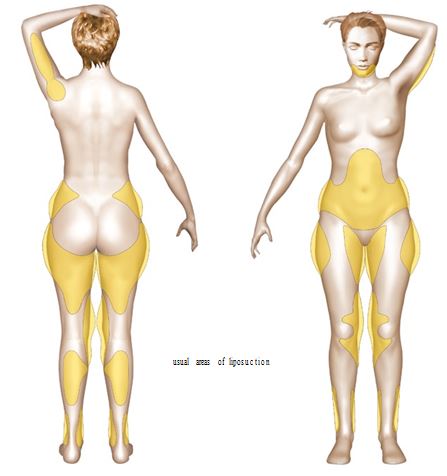Table of contents
LIPOSUCTION
This document has been conceived under the authority of the French Society of Plastic Reconstructive and Aesthetic surgery (Société Française de Chirurgie Plastique Reconstructrice et Esthétique – SOFCPRE) to complete the information that you received in your first consultation with your Plastic Surgeon. It aims to answer all the questions that you might ask, if you decide to undertake liposuction.
The aim of this document is to give you all the essential information you need in order to make an informed decision, with full knowledge of the facts related to this procedure. Consequently, we strongly advise you to read it carefully
Definition, aims and principles
Liposuction can radically and definitively diminish localized areas of protruding fat.
These localized areas of protruding fat do not go away with strict diet and exercise.
Conversely, liposuction is not a method for losing or controlling weight. Thus, a properly performed liposuction will not replace an improvement in lifestyle. Liposuction is not a treatment for obesity.
The principle of liposuction (as presented in 1977 by Yves-Gérard ILLOUZ) is to remove fat through very small skin incisions, with traumatic and blunt-tipped cannulas. These cannulas are attached to a closed negative pressure system.
Therefore, safe and sterile aspiration of excessive fat cells will be possible.
To the extent that these fatty cells are not able to re multiply, there will be no recurrence of these adipocytes growth.
Practically, liposuction can be applied to numerous body areas: hips, outer thighs, abdomen, knees, calves, ankles and upper arms. Technical improvements have permitted to extend its action to the face and neck (ie, double chin and face).
Recent progress in the field of superficial liposuction, performed with very thin cannulas have reduced skin trauma or bruising. It has even improved the final result by enhancing skin shrinkage, when performed with great attention and skill
Meanwhile, it must be kept in mind that liposuction, however common as it has become, remains a genuine surgical intervention, that ought to be performed by a skilled and qualified Plastic Surgeon, specially trained for this technique, in a truly surgical environment
The Health Insurance will not handle the treatment of these localized areas of protruding fat.

Before the operation
A preoperative check-up is made following your surgeon’s recommendations.
The anaesthesiologist will be seen in consultation at latest, 48 hours prior to surgery
Smoking is not a strict contraindication, but stop smoking one month before the operation is recommended due to its effect on scarring.
No medication containing aspirin will be taken for 10 days before surgery
According to the type of anaesthesia chosen, you may be asked not to eat or to drink for 6 hours before surgery.

Hospital stay and type of anesthesia
Type of anesthesia: Liposuction can be performed, depending on the amount of areas to be treated, either under local anaesthesia, local anaesthesia associated with intravenous
sedation or general anaesthesia. In some cases, regional anaesthetics, such as an epidural anaesthesia
The type of anaesthesia will be chosen after a discussion between yourself, your surgeon and your anaesthesiologist
Hospital stay:The duration of hospitalisation depends on the amount of fat removed. It can be short (a few hours) for small liposuctions under local anaesthesia, or longer (1 or 2 days) for larger liposuctions under general anaesthesia
The procedure
Every surgeon has his or her personal technical habits which he or she adapts to every new case, in order to obtain the best possible results. However, there are common principles:
Skin incisions are small (3 to 4 millimeters) and discrete, usually hidden in a natural fold.
Fat cells from deep and superficial fat layers are aspirated through smooth cannulas tunneled
though subcutaneous tissue layers, taking care to avoid nerves and blood vessels.
The amount of fat removed is adapted to the amount of the overlying skin, which represents a fundamental factor for the quality of the final result.
Post-operatively, a pressure dressing is made with an elastic bandage. Very often a special pressure garment is put on top of it.
The duration of the procedure depends on the amount of fat removed and on the number of body areas to treat. It can vary from 20 minutes to 3 hours (average time is 1 to 2 hours).
After the operation: post-operative effects
The necessary time needed to recover from surgery is proportional to the amount of excess fat removed.
After surgery, you will observe swelling and bruising in the treated areas.
Pain can vary from one patient to another, but it is usually mild, due to the use of very thin cannulas.
Fatigue is common in the first few post-operative days, especially after large liposuctions.
You can go back to your usual activity 3 to 6 days after surgery, again depending on the extent of your liposuction and your type of professional activity.
Bruising usually disappears 10 to 20 days after surgery.
It is strongly recommended to wear a pressure garment for 2 to 4 weeks.
It is possible to start sports again at least 3 weeks after surgery.
It is recommended to avoid exposure of the operated areas to the sun or to UV at least after 3 weeks.
There is no dramatic improvement of body contour in the first 2 to 3 weeks, because of the tissue swelling (edema) in the operated areas.
It is only after 3 weeks and with the resorption of this edema, that results will begin to appear. The skin will retract completely in 3 to 6 months over the new contours and readapt to the new silhouette.
The result
The final result can be best appreciated 6 months after the procedure. It is most satisfactory when the patient selection and technique are properly done, permitting removal of localized fat deposits and producing skin retraction.
The goal of this surgery is to make an improvement and not to achieve perfection. If your wishes are realistic, the result should give you great satisfaction.
Disappointing result
It has already been explained how liposuction, when correctly indicated and performed, can offer a real improvement to patients in terms of satisfying results and conformity to their expectations.

In some cases, localized imperfections can be observed, which must be distinguished from genuine complications: insufcient corrections, residual asymmetry, surface irregularities. These can be corrected secondarily under local anaesthesia after 6 months.
Possible complications
Liposuction, even if performed for aesthetic reasons, is a genuine surgical procedure, with the consequent risks related to all medical acts, no matter how mild they might appear.
There are surgical and aesthetic complications.
- Concerning anaesthesia, the anaesthesiologist will inform you about all the anaesthetic You must be aware that anaesthesia can sometimes cause unpredictable body reactions that can be difficult to control. The presence of an experienced anaesthesiologist, in a surgical environment, means that the risks are statistically practically negligible.
In fact, techniques, products and monitoring methods have progressed considerably over the last twenty years, offering optimal safety, especially when the operation is elective and the patient is in good general health.
- Concerning surgery: by choosing a competent and qualified Plastic Surgeon, experienced in performing this procedure, you limit, but do not entirely eliminate, surgical risks.
Indeed, some complications can occur after abdominoplasty (tummy tuck) which constitutes one of the most extensive and involved procedures in Plastic and Aesthetic Surgery.
Among possible complications, you must be aware of the following:
- Thrombo-embolic accidents (blood clot in the veins of the legs, pulmonary embolism) are the most severe complication. The risk is increased if such a complication figured in the patient’s history. They can be prevented by strict prophylactic measures, such as standing and walking as soon as possible after surgery, wearing compression stockings, or heparin therapy.
- Bleedings are rarely severe, except in case of associated coagulation disorder;
- Blood clots (haematomas) or lymphatic effusion are quite rare in a well performed liposuction;
- Also, localized skin necrosis which delay the scarring and leave scar, is not longer observed
- Infection, though common, can be treated with drainage and antibiotics
- Metabolic perturbations can occur in liposuction with a large quantity of protruding fat.

All things considered, the risks must not be overestimated, but you must be conscious that an operation, even a minor one, always has some degree of unforeseenable unknown factors.
You can be assured that if you are operated on by a qualified Plastic Surgeon, he will have the experience and skill required to avoid these complications, or to treat them successfully if necessary.
Tell us what you think.
These booklets are regularly reviewed.
We welcome any suggestions to help us improve this booklet. You should send these to Patient and Family Eduacation Commitee, Fv Hospital, 06 Nguyen Luong Bang Street, Saigon South (Phu My Hung), District 7, Ho Chi Minh City, Vietnam

